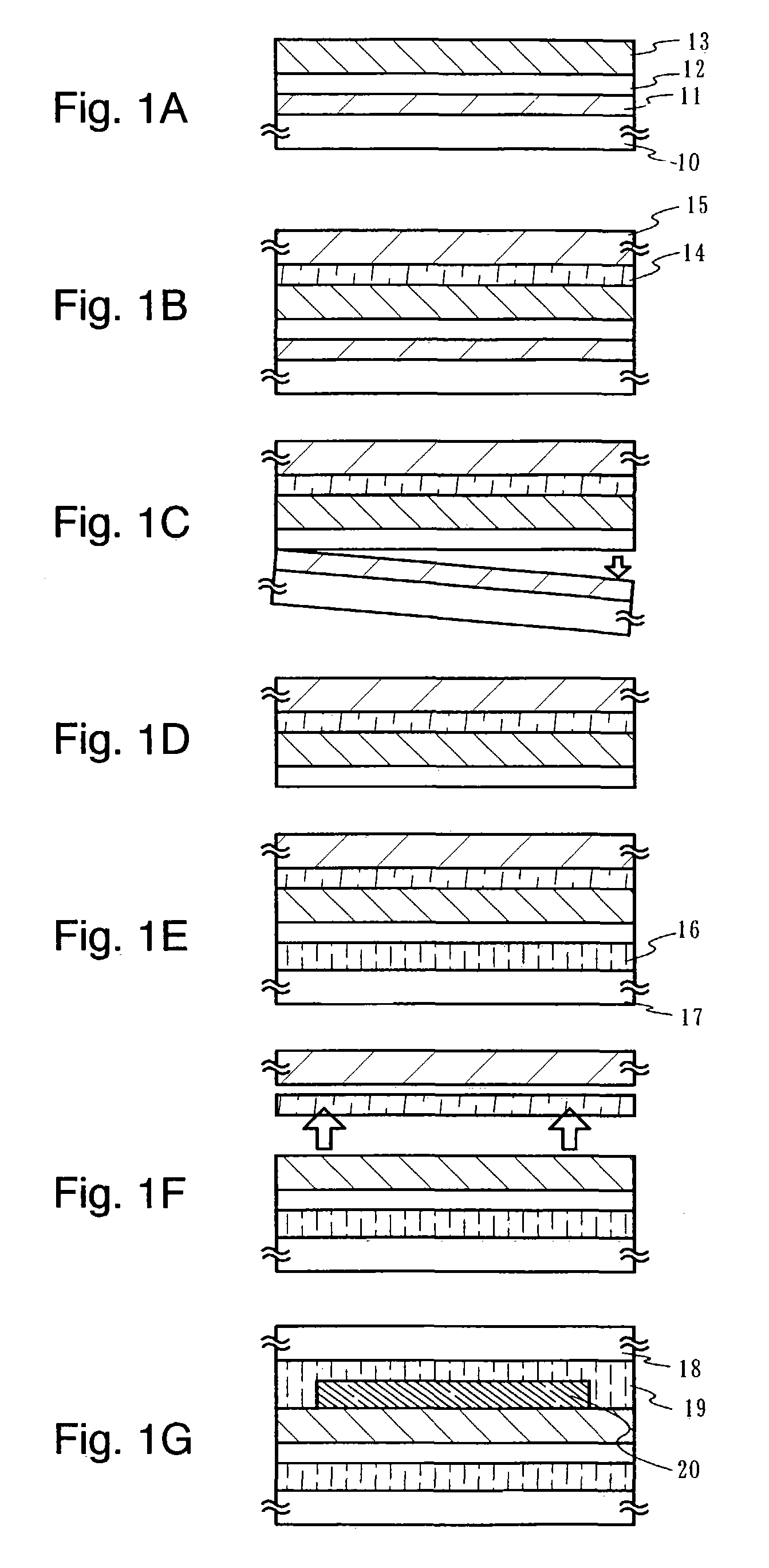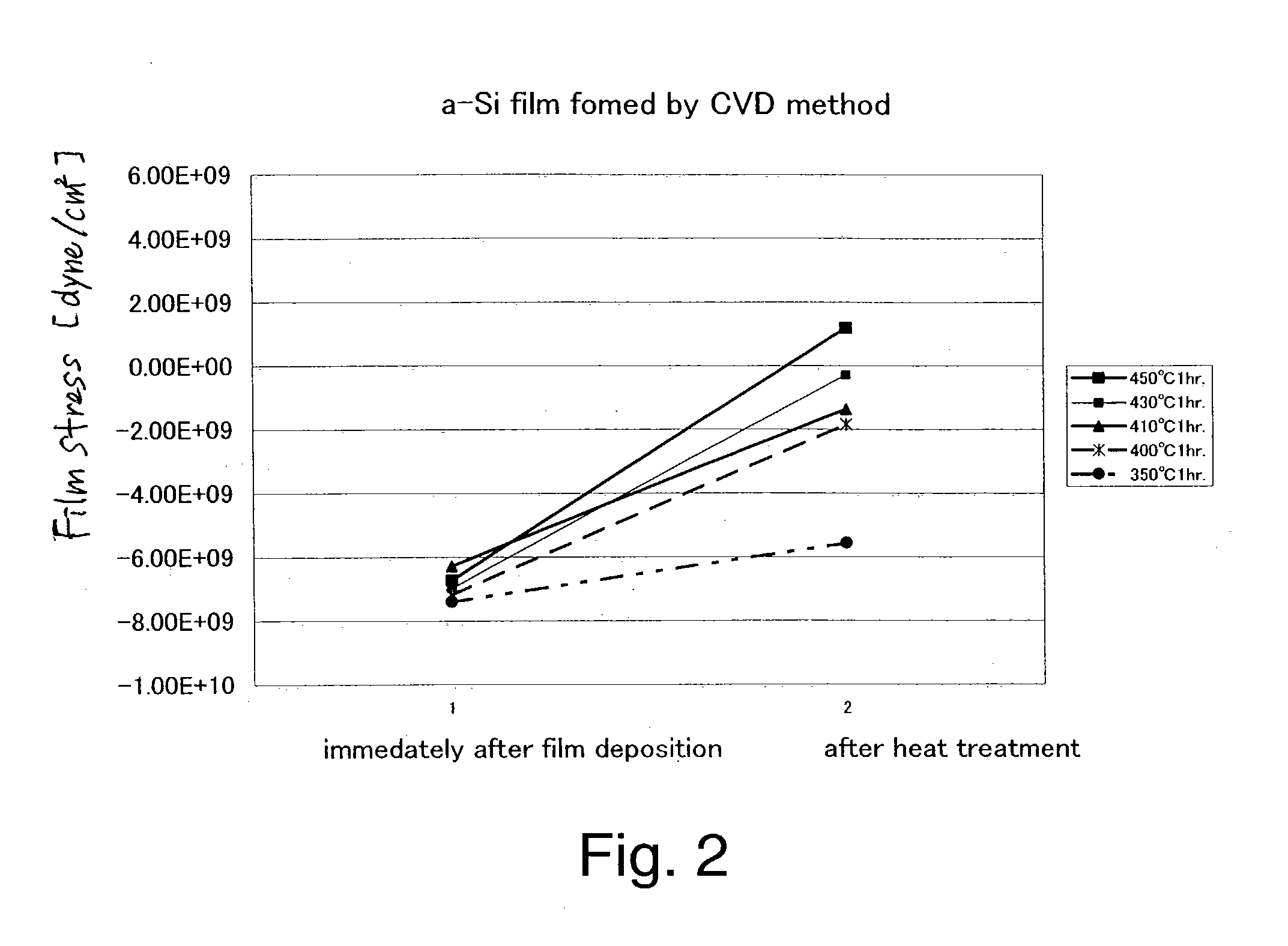Peeling method
a peeled layer and peeled technology, applied in the direction of semiconductor devices, electrical apparatus, transistors, etc., can solve the problems of difficult cracks and heavyness, inability to form any tft with electric characteristics, and difficult enlargement of glass substrates, etc., to and promote deterioration of organic compound layers
- Summary
- Abstract
- Description
- Claims
- Application Information
AI Technical Summary
Benefits of technology
Problems solved by technology
Method used
Image
Examples
experiment 1
[0084]An amorphous silicon film containing hydrogen was formed on a glass substrate by PCVD (film deposition temperature of 300° C., film deposition gas SiH4), then, heat treatments were performed under various conditions, and the respective stresses were measured. The obtained results are shown in FIG. 2. The respective heat treatment conditions are: 350° C. for one hour; 400° C. for one hour; 410° C. for one hour; 430° C. for one hour; and 450° C. for one hour.
[0085]It is seen from FIG. 2 that the stress value obtained through the heat treatment is changed more toward a tensile stress compared with the stress value obtained immediately after the film deposition (−8×109 (Dyne / cm2) to −6×109 (Dyne / cm2)) under any condition. The stress value obtained after the heat treatment falls in a range of −6×109 (Dyne / cm2) to 2×109 (Dyne / cm2).
[0086]Further, a tungsten film, a silicon oxide film formed by sputtering, a base insulating film, and an amorphous silicon film containing hydrogen forme...
experiment 2
[0087]As to the amorphous silicon film containing hydrogen obtained by PCVD under the same condition as in Experiment 1, a hydrogen concentration thereof was measured through FT-IR. As a result, Si—H was 1.06×1022 (atoms / cm3), Si—H2 was 8.34×1019 (atoms / cm3), and the calculated hydrogen concentration in the composition ratio was 21.5%. Further, the hydrogen concentration was similarly calculated under the changed film deposition conditions with PCVD, as a result of which the obtained hydrogen concentrations in the composition ratio were 16.4%, 17.1%, and 19.0%.
[0088]Further, a tungsten film, a silicon oxide film formed by sputtering, a base insulating film, and an amorphous silicon film containing hydrogen formed by PCVD (film with a hydrogen concentration in the composition ratio is 16.4% to 21.5%) were sequentially laminated on a glass substrate. The heat treatment at 410° C. for one hour was performed to each of the resultant lamination layers. Then, a peeling experiment was perf...
experiment 3
[0090]Here, a W film (100 nm) and a silicon oxide film (100 nm) were laminated on a silicon wafer. Then, heat treatments (at 350° C. for one hour, 400° C. for one hour, 410° C. for one hour, 430° C. for one hour, and 450° C. for one hour) were performed thereto. Further, etching was conducted to the silicon oxide film. The results of the measurement of the stress change for the respective treatments are shown in FIG. 3.
[0091]As to the deposition condition of the W film, a tungsten target was used with sputtering, and a film deposition pressure of 0.2 Pa, a film deposition power of 3 kW, and an argon flow rate of 20 sccm were adopted.
[0092]Further, as to the deposition condition of the silicon oxide film: an RF type sputtering device was used; a silicon oxide target (with a diameter of 30.5 cm) was used; an argon gas heated for heating a substrate was flown at a flow rate of 30 sccm; and a substrate temperature of 300° C., a film deposition pressure of 0.4 Pa, a film deposition power...
PUM
 Login to View More
Login to View More Abstract
Description
Claims
Application Information
 Login to View More
Login to View More - R&D
- Intellectual Property
- Life Sciences
- Materials
- Tech Scout
- Unparalleled Data Quality
- Higher Quality Content
- 60% Fewer Hallucinations
Browse by: Latest US Patents, China's latest patents, Technical Efficacy Thesaurus, Application Domain, Technology Topic, Popular Technical Reports.
© 2025 PatSnap. All rights reserved.Legal|Privacy policy|Modern Slavery Act Transparency Statement|Sitemap|About US| Contact US: help@patsnap.com



